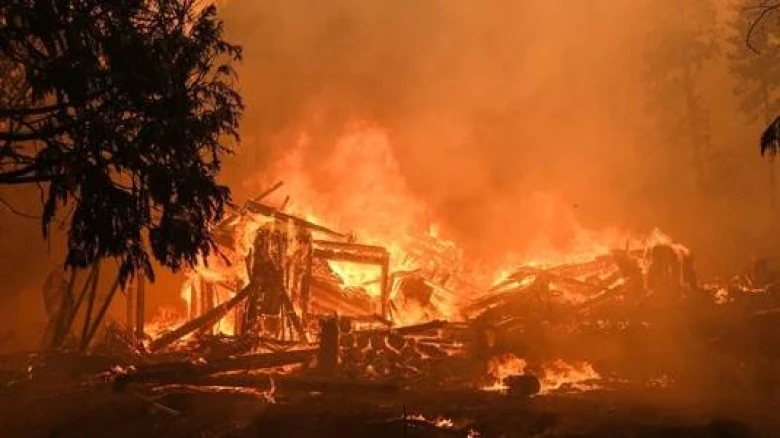International

A significant shift in water temperatures from west to east in the tropical Pacific Ocean during the previous winter, according to scientists, is the primary source of heat domes.
color:black;mso-themecolor:text1">
color:black;mso-themecolor:text1">Digital Desk: The last week saw almost all of
the contiguous United States endure above-average temperatures, and more
dangerously hot weather is predicted.
color:black;mso-themecolor:text1">The European continent experienced wildfires
and hundreds, if not thousands, of deaths due to record temperatures that
preceded the US heat wave.
color:black;mso-themecolor:text1">What, in the opinion of scientists, is
producing the heat waves is explained below.
color:black;mso-themecolor:text1">WHAT DO HEAT WAVES DO?
mso-themecolor:text1">There is no one scientific definition of a heat wave. The
number of days over a particular temperature or percentile above the norm can
be used to gauge a region's climate.
mso-bidi-font-weight:bold">THE JET STREAM AND ARCTIC WARMING
mso-bidi-font-weight:bold">There is a shrinking difference between temperatures
in the north and those closer to the equator because the Arctic is warming
three to four times faster than the rest of the world.
mso-bidi-font-weight:bold">According to Jennifer Francis, senior scientist at
the Woodwell Climate Research Center, this is causing changes in the North
Atlantic jet stream, which in turn causes extreme weather conditions including
heat waves and floods.
Heat DOMES
color:black;mso-themecolor:text1;font-weight:normal;mso-bidi-font-weight:bold">Heat
domes, which trap heat across wide portions of the earth's surface, are caused
by warmer waters. According to the U.S. Weather Prediction Center, the heat
dome this weekend is extending from the southern plains of the
Oklahoma/Arkansas region all the way to the eastern seaboard.
mso-bidi-font-weight:bold">
color:black;mso-themecolor:text1">A significant shift in water temperatures
from west to east in the tropical Pacific Ocean during the previous winter,
according to scientists, is the primary source of heat domes.
mso-themecolor:text1">According to the U.S. National Oceanic and Atmospheric
Administration, "while prevailing winds bring the hot air east, the
northern shifts of the jet stream trap the air and move it toward land, where
it sinks, resulting in heat waves."
mso-themecolor:text1">
color:black;mso-themecolor:text1;font-weight:normal;mso-bidi-font-weight:bold">EL
NIÑO AND LA NIÑA
color:black;mso-themecolor:text1">
mso-themecolor:text1">Every few years, the climate patterns
https://oceanservice.noaa.gov/facts/ninonina.html known as El Niño and, less
frequently, La Niña occur. El Niño brings warm water from the equatorial
Pacific Ocean up to the western coast of North America, and La Niña brings
colder water.
mso-themecolor:text1">
mso-themecolor:text1">At present, La Niña is in effect. Because summer temperatures
trend lower during La Niña, climate scientists are concerned about what a
serious heat wave would look like during the next El Niño, when even hotter
summer weather could be expected.
mso-themecolor:text1">
HUMANITARIAN-INITIATED
CLIMATE CHANGE
mso-bidi-font-weight:bold">According to scientists, the United States is
suffering some of the effects of global climate change brought on by the
combustion of fossil fuels.
mso-bidi-font-weight:bold">According to UCLA climate scientist Daniel Swain,
"Climate change is making extreme and unusual heat events both more
intense and more prevalent, pretty much everywhere in the world."
color:black;mso-themecolor:text1;font-weight:normal;mso-bidi-font-weight:bold">"Because
they frequently result in a large number of fatalities, heat waves are
certainly the type of potential calamity that is most underrated. And we simply
don't hear about it because, to put it clearly, it doesn't kill people in
sufficiently dramatic ways. No bodies are lying in the roadway."
color:black;mso-themecolor:text1">According to Francis of the Woodwell Center,
climate change is causing changes in wind patterns and weather patterns around
the planet, which "make these heat waves, like the ones we're experiencing
right now, more intense, more persistent, and cover areas that just aren't used
to having heat waves."
According
to NASA's Goddard Institute for Space Studies researcher Alex Ruane, as the
planet heats, "We are more easily pushed into the extreme heat categories
by natural anomalies. You're more likely to experience multiple heat waves at
once since we're getting closer to those thresholds. This is happening here in
the US."
Leave A Comment